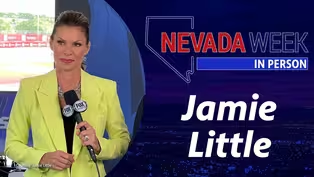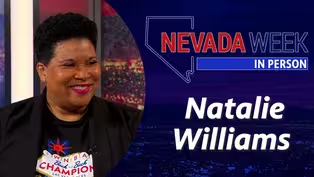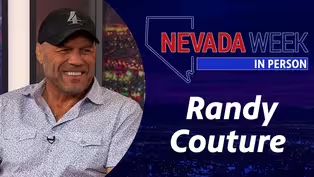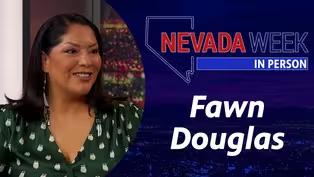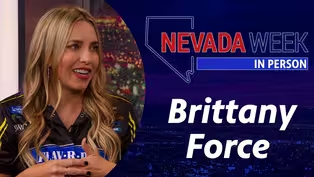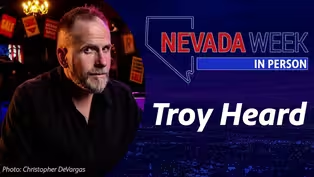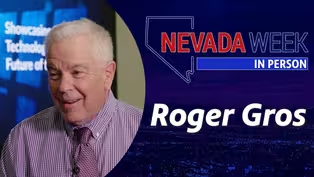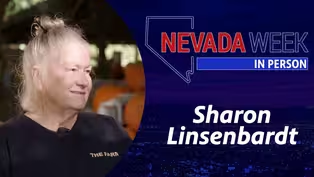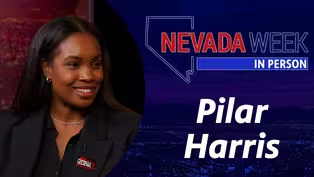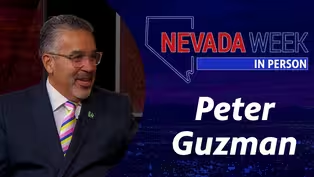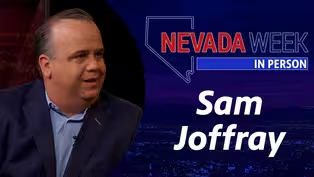
Nevada Week In Person | Maureen Romito
Season 1 Episode 57 | 14mVideo has Closed Captions
One-on-one interview with co-executive director of Impact Las Vegas Maureen Romito.
One-on-one interview with founder and co-executive director of Impact Las Vegas Maureen Romito.
Problems playing video? | Closed Captioning Feedback
Problems playing video? | Closed Captioning Feedback
Nevada Week In Person is a local public television program presented by Vegas PBS

Nevada Week In Person | Maureen Romito
Season 1 Episode 57 | 14mVideo has Closed Captions
One-on-one interview with founder and co-executive director of Impact Las Vegas Maureen Romito.
Problems playing video? | Closed Captioning Feedback
How to Watch Nevada Week In Person
Nevada Week In Person is available to stream on pbs.org and the free PBS App, available on iPhone, Apple TV, Android TV, Android smartphones, Amazon Fire TV, Amazon Fire Tablet, Roku, Samsung Smart TV, and Vizio.
Providing Support for PBS.org
Learn Moreabout PBS online sponsorshipMore from This Collection
Nevada Week In Person goes beyond the roundtable discussion of Nevada Week with guests for a more casual conversation about their personal passions, new projects and compelling stories that are overlooked in the flurry of the news cycle.
Nevada Week In Person | Jamie Little
Video has Closed Captions
One-on-one interview with Jamie Little, NASCAR Broadcaster (14m)
Nevada Week In Person | Chet Buchanan
Video has Closed Captions
One-on-one interview with Chet Buchanan,Host & Creator, 98.5 KLUC’s The Chet Buchanan Show (14m)
Nevada Week In Person | Natalie Williams
Video has Closed Captions
One-on-one interview with Natalie Williams, General Manager, Las Vegas Aces (14m)
Nevada Week In Person | Randy Couture
Video has Closed Captions
One-on-one interview with Randy Couture, UFC Hall of Famer & U.S. Army Veteran (14m)
Nevada Week In Person | Fawn Douglas
Video has Closed Captions
One-on-one interview with Fawn Douglas, Artist and Activist, Nuwu Art (14m)
Nevada Week In Person | Brittany Force
Video has Closed Captions
One-on-one interview with Brittany Force, World Champion Drag Racer (14m)
Nevada Week In Person | Troy Heard
Video has Closed Captions
One-on-one interview with Troy Heard, Artistic Director, Majestic Repertory Theatre (14m)
Nevada Week In Person | Roger Gros
Video has Closed Captions
One-on-one interview with Roger Gros, Publisher, Global Gaming Business Magazine (14m)
Video has Closed Captions
One-on-one interview with Sharon Linsenbardt, Owner, Las Vegas Farm and Barn Buddies Rescu (14m)
Nevada Week In Person | Pilar Harris
Video has Closed Captions
One-on-one interview with Pilar Harris (14m)
Nevada Week In Person | Peter Guzman
Video has Closed Captions
One-on-one interview with Latin Chamber of Commerce Nevada President & CEO Peter Guzman (14m)
Nevada Week In Person | Sam Joffray
Video has Closed Captions
One-on-one interview with Sam Joffray, President & CEO, Las Vegas Super Bowl LVII Host Com (14m)
Providing Support for PBS.org
Learn Moreabout PBS online sponsorshipThere's power in numbers.
That's the premise of the local nonprofit Impact Las Vegas whose founder, Maureen Romito, is our guest this week on Nevada Week In Person .
♪♪♪ Support for Nevada Week In Person is provided by Senator William H. Hernstadt.
Welcome to Nevada Week In Person .
I'm Amber Renee Dixon.
Her last name may not be Wynn or Buffett, but in the 10 years since starting her Vegas based nonprofit, she's managed to make quite the impact.
Maureen Romito, founder and executive director, co-executive director of Impact Las Vegas, thank you for joining Nevada Week In Person .
(Maureen Romito) Oh, thank you so much for having me.
-And that line about your last name not being Wynn or Buffett, I've heard you use it yourself in interviews before.
And I wonder why you think it's important to bring that up?
-Well, when I was first deciding how much and how I wanted to give back to this community that I call home and love, it was, Can I really afford to do as much as I would hope to do and make a difference, that I could actually see the impact of what I was trying to do and really make a change in our community.
And I couldn't afford anything as well as a Buffett could.
Or as wonderful as Elaine Wynn is and what she's been able to do for the community, there's no way I could do that on my own.
And so when I learned about collective giving, it was like a light bulb went off, that this was a perfect way to be able to multiply my annual giving and make a much bigger difference.
-What is "collective giving"?
How does it work?
-Well, collective giving is where you have a group of women, in this case for Impact Las Vegas, that we get together, and by the end of December every year, we each donate $1,000 at least, and we combine that $1,000 into one giant pool of money.
For instance, this past year, we ended with 95 members.
So we have a $95,000 grant that we will then give out in June of this coming year.
And all of our members get to volunteer and evaluate the grant applicants that we encourage to apply for that $95,000, narrow the focus down to a few finalists, and then get to vote.
Each of us gets one vote for our $1,000 and pick who actually receives the $95,000 grant.
-That's spectacular!
-It really is.
Because every year I feel, like for this year, I didn't just give 1,000, I'm giving $95,000 back to the community.
-And it's important to have that large sum for just one organization, correct, instead of piecemealing it?
-Well, we feel it's more transformative for some nonprofits to have a large grant, but we also don't want to get to the stage where it's so big that only certain nonprofits could afford to do that.
So every year our members get together and we talk about, you know, how much do we have?
Do we want to split it maybe into two grants?
But so far, we've only been giving one grant for the total amount as we've been growing.
But once we get bigger, we may give multiple grants down the road.
-And remind me.
When will you be giving out this grant?
When does the grant application close?
-We announced the amount in January.
Right now, the nonprofits have been invited to submit what we call a "letter of inquiry."
The deadline for that is February 1 of this year.
Our members will then evaluate that, narrow it down to like about 16 nonprofits that we want to learn more about; they'll submit a full grant application; we'll review those by the end of-- during April; and then in May, we'll do site visits for our four semifinalists.
In the beginning of June, all our members get together and vote for who the two-- between the two finalists of who gets the grant.
-This is empowering for women.
-Absolutely.
-But it's also educational.
How so?
-It is.
Well, you learn about, first of all, what the needs are in the community.
And that was one of the biggest surprises I had when I first started is, Oh, my goodness, the number of nonprofits that exists, large and small, across southern Nevada, and in all of Nevada, actually, to find out the need that's out there, what the wonderful work these nonprofits are doing to address that.
And we also learn about the grant process, how to evaluate to see what's the best use of our funding.
Some nonprofits do a really great job of explaining how they're going to spend the money.
Some may not do as great a job of that.
So after the first year, we discovered that it made sense for us to start doing training for some of our nonprofits.
So every year we invite the nonprofits to learn about how do we-- what do we ask for, how do we evaluate them, and what will help.
I mean, I can't predict what will sing to me as an individual and make me go, Ooh, I want to give them the grant, because I'm just one vote.
But we can encourage them to, you know, if you tell us exactly how you're spending the money, if you, you know, understand that we're trying to see what kind of impact our grant will make to the community, that's the important thing.
-And how do you go about ensuring once you decide who's going to get the grant that it is used wisely?
-Well, we do tell them upfront exactly what their-- the requirements are going to be.
They sign a grant agreement, the individual nonprofit that actually wins the grant award, and they have to do, usually quarterly or at least twice a year, reporting to us about how-- what have they spent so far?
What have they done?
Who have they affected?
It's all laid out in the grant agreement.
We share that with our members.
Every November, we have what we call our "Celebrator Impact" where we invite our members to meet the current year and the previous year's nonprofit, where they will give us an update on what's been happening.
And sometimes there's payments that go out over time periods, so they have to meet those requirements before they get the next payment.
Other times, we've had one instance where it was paid upfront, because of what it was they were spending the money on.
But again, there's the follow-up with them and with us to make sure that they're doing what they said they were going to do with the money.
And we've been, knock on wood, very lucky that we've had no challenges in that respect.
-Why women?
Why limit it to women?
-Well, it's funny.
When I first started hearing about it-- It's based on a model that is based on women giving.
But women usually-- we're wealthier than we used to be in the past.
We have a lot to say within our families about how we spend money, and research has shown that women are actually more generous than men are.
And we love to do things collectively as a group.
We like to see the impact we're able to have.
We like to make a change within communities and in the world.
So it's just a lot of like-minded people getting together, and women is just a great way to say it, that's what it is.
-And so it's a $1,000 a year commitment?
-It is.
-Who is the ideal woman for this?
For some, that may be a lot of money.
For others, sort of okay.
-Exactly.
-And others, totally doable.
-Even when I looked back about, What did I used to do before I joined a group like this?
How did I used to give money?
Sometimes you do money through your paycheck at work and things?
Well, it's only about 85 bucks a month to pay to get to $1,000 at the end of the year.
And $85 a month, and maybe gave up a Starbucks every day, but 85 bucks a month wasn't too bad to be able to do it.
Or even paying every three months, you know, $250.
It's a little bit more reasonable.
And then as you said, there's some women that the 1,000 is not a huge horrible thing to do.
And for some older people, if they're collecting out of their retirement funds, they can take it directly from the retirement funds and not have to pay taxes, but it still counts as one of their distributions.
So it's a win-win for them in that respect.
-In your 10th year, take me back 10 years ago, where you were in your life when you decided this was what you were going to do?
-Well, I was lucky enough to be able to retire and be able to say, All right, now I'm going to want to do something to give back to this community because I focused on my career this whole time.
What did I want to do?
How did I want to do this, and finding out about collective giving was the perfect solution.
And it would keep me busy.
It would help, you know-- I applied for the 501(c)(3) to become recognized by the IRS as a nonprofit, and putting all the processes in place.
And it's based on a model that is over 60 cities across the U.S. We're not chapters, we're not subsidiaries, but we all share information with each other.
So we don't have to reinvent the wheel, but at the same time, we adapt it to our community so that it works best for all of us.
But everyone told me, you know, the best way to do it is to be transformative and get 100 women together.
And I said, Well, you know, I don't really know 100 women.
I've been so busy on my career, I haven't really gotten that much involvement.
They said, Well, you don't need to.
You just need to know five women who know five women who know five women.
Oh, I can do that.
Well, initially, the five women I knew, knew the same five women, so we've been growing very slowly over the years.
So we started with 13 members, and luckily, I had a nonprofit consultant who advised me, "Show them you're a good steward with the money.
Don't wait till you hit 100 members.
Give out that first 13,000."
And every year, we've just given out a little bit more every year.
And the nonprofit community has been amazing.
We've always had at least 70 nonprofits apply for whatever our grant is.
-Wow!
-Yeah.
-First year that you did it, it was 13,000.
So 13 women-- -Correct.
- --and has grown to now 95 women I think you said.
-95 women, yes.
-And your career that you mentioned was in human resources and very high level as well.
Coming out of that corporate environment, did you feel a need to fill some sort of hole.
-Yes.
Because I knew if left on my own, I couldn't just go straight to doing nothing or just having hobbies.
I wanted something to keep me challenged, something I could still learn, and as I said, I wanted to give back.
And learning about the nonprofit world, learning about the collective giving world, and putting processes in place and all of that really sang to me and helped me do that.
And I love making presentations, so being able to talk about that was good.
-What are the benefits for people simply giving?
-The best part I found-- Well, there's several different things.
One is 100% of my 1,000 goes towards the grant.
Yes, we do have to spend some money to operate the organization even though we're all volunteer run.
There are things you can't avoid, like for insurance, things like that you've got to pay for.
So some of our members are generous enough to give us a little bit extra to help us cover those expenses.
-Operational.
-Operational costs, exactly.
But we try to keep them as low as possible since we're all volunteer.
But there's also the benefit of knowing that, I'm going to get to see exactly how my money is spent.
I mean, I've given money in the past.
I know it's doing good, but how they're actually spending it, I may not have known.
This one, I'm getting reports.
I get to see exactly how it's spent.
-And give me an example of one of the organizations that's benefited from your grant that sticks out to you.
-Oh, there's a lot of them.
-Right.
-There's an awful lot of them.
Our second year we did Nevada Child Seekers where we helped them expand their Be Brave program, which is a youth empowerment antibullying program in the Clark County School District.
Well, our grant was a catalyst for them to expand to even more schools.
And they were even expanding to Reno and even talking to California.
So we knew we had an impact with that particular grant.
And then there's other grants; for instance, the Just One project.
They distribute food throughout the community within free pop-up markets, and senior citizens and everything.
And they had a really old truck that was in the danger of failing, and we were able to buy them a new refrigerated truck that helps them make those deliveries.
And that we know when we see the truck go by somewhere in the community, we did that; you can point to it and know that that was what-- we had that impact too to our community.
-What do you attribute your growth to?
Did you have a nonprofit mentor or something?
-The nonprofits were probably the best mentors for me for helping me develop the processes and for helping us understand what works best for grants, et cetera.
The community has been actually growing through our members.
Our members just spread the word with neighbors, relatives, friends, and that's how we have been able to grow.
And making people aware of what it is that we do is probably the toughest job, because this is a busy town with a lot of noise and a lot of things going on.
But we're slowly getting the word out, and people are spreading the news about what it works.
And I think people understand collective giving more maybe now than they might have when I first started.
So-- Because I remember I couldn't use the word "philanthropist" when I first started, because a lot of us didn't think we were philanthropists.
That's what Elaine Wynn is, you know, Warren Buffett is, a philanthropist.
But philanthropy really means you're just doing-- you're giving money and truly being involved in understanding how it's being used, what's the best use of it, where it's going, et cetera.
And we've all become better philanthropists because of that.
-So you feel comfortable calling yourself that now?
-We do now.
-Maureen Romito, philanthropist with Impact Las Vegas, thank you for your time.
Thank you for joining us.
And to see more of Nevada Week In Person, go to vegaspbs.org/nevadaweek.
♪♪♪

- News and Public Affairs

Top journalists deliver compelling original analysis of the hour's headlines.

- News and Public Affairs

FRONTLINE is investigative journalism that questions, explains and changes our world.












Support for PBS provided by:
Nevada Week In Person is a local public television program presented by Vegas PBS
